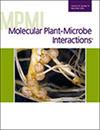Qi Wang, Kira M Veley, Joshua M B Johnson, Josh Sumner, Gijs van Erven, Mirjam A Kabel, Singha Dhungana, Jeffrey Berry, Adam Boyher, David M Braun, Wilfred Vermerris, Rebecca S Bart
求助PDF
{"title":"三种黄单胞菌细胞壁降解酶和高粱褐中脉12对细菌条纹病毒力和抗性的影响","authors":"Qi Wang, Kira M Veley, Joshua M B Johnson, Josh Sumner, Gijs van Erven, Mirjam A Kabel, Singha Dhungana, Jeffrey Berry, Adam Boyher, David M Braun, Wilfred Vermerris, Rebecca S Bart","doi":"10.1094/MPMI-05-24-0051-R","DOIUrl":null,"url":null,"abstract":"<p><p>With an increasing demand for renewable fuels, bioenergy crops are being developed with high sugar content and altered cell walls to improve processing efficiency. These traits may have unintended consequences for plant disease resistance. <i>Xanthomonas vasicola</i> pv. <i>holcicola</i> (<i>Xvh</i>), the causal agent of sorghum bacterial leaf streak, is a widespread bacterial pathogen. Here, we show that <i>Xvh</i> expresses several bacterial cell wall degrading enzymes (CWDEs) during sorghum infection, and these are required for full virulence. In tolerant sorghum, <i>Xvh</i> infection results in the induction of a key enzyme in monolignol biosynthesis, <i>Brown midrib12</i> (<i>Bmr12</i>), but this did not affect lignin content nor composition. Mutation of <i>Bmr12</i> rendered the tolerant genotype susceptible. <i>Bmr12</i> encodes caffeic acid <i>O</i>-methyltransferase (COMT), an enzyme that generates sinapaldehyde as its major product. Growth inhibition of <i>Xvh</i> in the presence of sinapaldehyde was observed in vitro. We conclude that mutations that alter the components of the sorghum cell wall can reduce sorghum resistance to <i>Xvh</i> and that <i>Xvh</i> CWDEs contribute to bacterial virulence. Given the enhanced bioprocessing characteristics of <i>bmr12</i> sorghum, these results provide a cautionary tale for current and future efforts aimed at developing dedicated bioenergy crops. [Formula: see text] Copyright © 2025 The Author(s). This is an open access article distributed under the CC BY 4.0 International license.</p>","PeriodicalId":19009,"journal":{"name":"Molecular Plant-microbe Interactions","volume":" ","pages":"400-410"},"PeriodicalIF":3.4000,"publicationDate":"2025-05-01","publicationTypes":"Journal Article","fieldsOfStudy":null,"isOpenAccess":false,"openAccessPdf":"","citationCount":"0","resultStr":"{\"title\":\"Three <i>Xanthomonas</i> Cell Wall Degrading Enzymes and Sorghum <i>Brown midrib12</i> Contribute to Virulence and Resistance in the Bacterial Leaf Streak Pathosystem.\",\"authors\":\"Qi Wang, Kira M Veley, Joshua M B Johnson, Josh Sumner, Gijs van Erven, Mirjam A Kabel, Singha Dhungana, Jeffrey Berry, Adam Boyher, David M Braun, Wilfred Vermerris, Rebecca S Bart\",\"doi\":\"10.1094/MPMI-05-24-0051-R\",\"DOIUrl\":null,\"url\":null,\"abstract\":\"<p><p>With an increasing demand for renewable fuels, bioenergy crops are being developed with high sugar content and altered cell walls to improve processing efficiency. These traits may have unintended consequences for plant disease resistance. <i>Xanthomonas vasicola</i> pv. <i>holcicola</i> (<i>Xvh</i>), the causal agent of sorghum bacterial leaf streak, is a widespread bacterial pathogen. Here, we show that <i>Xvh</i> expresses several bacterial cell wall degrading enzymes (CWDEs) during sorghum infection, and these are required for full virulence. In tolerant sorghum, <i>Xvh</i> infection results in the induction of a key enzyme in monolignol biosynthesis, <i>Brown midrib12</i> (<i>Bmr12</i>), but this did not affect lignin content nor composition. Mutation of <i>Bmr12</i> rendered the tolerant genotype susceptible. <i>Bmr12</i> encodes caffeic acid <i>O</i>-methyltransferase (COMT), an enzyme that generates sinapaldehyde as its major product. Growth inhibition of <i>Xvh</i> in the presence of sinapaldehyde was observed in vitro. We conclude that mutations that alter the components of the sorghum cell wall can reduce sorghum resistance to <i>Xvh</i> and that <i>Xvh</i> CWDEs contribute to bacterial virulence. Given the enhanced bioprocessing characteristics of <i>bmr12</i> sorghum, these results provide a cautionary tale for current and future efforts aimed at developing dedicated bioenergy crops. [Formula: see text] Copyright © 2025 The Author(s). This is an open access article distributed under the CC BY 4.0 International license.</p>\",\"PeriodicalId\":19009,\"journal\":{\"name\":\"Molecular Plant-microbe Interactions\",\"volume\":\" \",\"pages\":\"400-410\"},\"PeriodicalIF\":3.4000,\"publicationDate\":\"2025-05-01\",\"publicationTypes\":\"Journal Article\",\"fieldsOfStudy\":null,\"isOpenAccess\":false,\"openAccessPdf\":\"\",\"citationCount\":\"0\",\"resultStr\":null,\"platform\":\"Semanticscholar\",\"paperid\":null,\"PeriodicalName\":\"Molecular Plant-microbe Interactions\",\"FirstCategoryId\":\"99\",\"ListUrlMain\":\"https://doi.org/10.1094/MPMI-05-24-0051-R\",\"RegionNum\":3,\"RegionCategory\":\"生物学\",\"ArticlePicture\":[],\"TitleCN\":null,\"AbstractTextCN\":null,\"PMCID\":null,\"EPubDate\":\"2025/3/13 0:00:00\",\"PubModel\":\"Epub\",\"JCR\":\"Q2\",\"JCRName\":\"BIOCHEMISTRY & MOLECULAR BIOLOGY\",\"Score\":null,\"Total\":0}","platform":"Semanticscholar","paperid":null,"PeriodicalName":"Molecular Plant-microbe Interactions","FirstCategoryId":"99","ListUrlMain":"https://doi.org/10.1094/MPMI-05-24-0051-R","RegionNum":3,"RegionCategory":"生物学","ArticlePicture":[],"TitleCN":null,"AbstractTextCN":null,"PMCID":null,"EPubDate":"2025/3/13 0:00:00","PubModel":"Epub","JCR":"Q2","JCRName":"BIOCHEMISTRY & MOLECULAR BIOLOGY","Score":null,"Total":0}
引用次数: 0
引用
批量引用

 求助内容:
求助内容: 应助结果提醒方式:
应助结果提醒方式:


